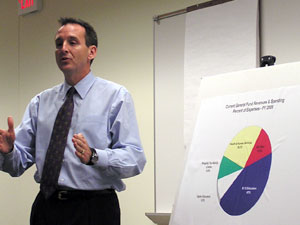|
Audio
Photos
More from MPR
Your Voice
|
As budget-cutting time nears, Minnesota prioritizes
October 7, 2004
 |
| Gov. Tim Pawlenty has made it clear that the budget he proposes early next year will not include a tax increase. (MPR Photo/Laura McCallum) |
St. Paul, Minn. — Gov. Pawlenty just wrapped up a series of budget listening sessions around the state with randomly-selected citizens. At the final session in Blaine this week, 14 citizens were divided about whether to raise taxes to balance the state budget, and where to cut state spending.
Ken Schonrock of Spring Lake Park, a retired state employee who said he sees too many state needs, from exploding health care costs to traffic gridlock, told Pawlenty he's perplexed by the governor's no-tax-increase stance.
 | |||
"All these needs, and yet you refuse to increase taxes of any kind, it seems. Why aren't you more open, more flexible?" Schonrock said.
Pawlenty told Schonrock that raising taxes will make Minnesota less competitive by suffocating investment and job growth in the state.
"We are one of the most highly-taxed states in the country. In the country. So if you want more money for corrections, or you want more money for schools, then let's take it from something else because we got a budget that's growing," the governor said.
Pawlenty has made it clear that the budget he proposes early next year will not include a tax increase. But it might include gaming money. He asked citizens if they thought the state's Indian tribes should contribute some of their gaming profits to the state, and many nodded their heads.
He's also left the door open to a proposal to add slot machines at Canterbury Park. And Pawlenty has indicated he would like to give schools more money, which could mean deeper cuts in other areas of the state budget.
The chair of the Senate Finance Committee, St. Paul DFLer Dick Cohen, says the state has already used up virtually all of its reserves and other pots of money that could only be tapped once. He says the budget situation looks bleak.
"We're in as difficult a position as we've ever been in," according to Cohen. "We're not seeing the kind of economic growth that would allow for us to meet citizen expectations. And I think we're seeing areas of the state budget -- notably health care -- that start to reach a point where it becomes very, very difficult to put a budget together."
Pawlenty often tells groups that health care is the biggest cost driver in state government, and unless costs are reined in, health care will consume the state budget within 15 years. His last budget shrunk the projected growth in health care spending, partly through higher fees and co-pays for people receiving state health care services. His next budget is likely to include more of that.
To prepare for the governor's budget, state Human Services Commissioner Kevin Goodno says his agency has been prioritizing the services it provides.
"It's not easy. These programs have developed over time and some people have ownership in those programs. But I think sometimes it's important for us to have a reality check as to what programs are most important to the people we serve," Goodno said.
Goodno says that includes services for the most vulnerable Minnesotans who can't take care of themselves. State agency heads recently submitted priority plans to the Finance Department. The plans rank the 20 percent of the agency's budget that it considers the highest priority, the middle 60 percent, and the bottom 20 percent.
Finance Commissioner Peggy Ingison says the Pawlenty administration wants to build its next budget by starting with what it considers core services.
"Usually what happens is we start with the assumption that everything that's funded continues to be funded, and then we start to take away from that. So what we're trying to do at this point is say: what are the priorities that we're spending our money on?" she said.
Ingison says state agencies shouldn't assume that the bottom 20 percent of their budgets will be cut. But Jim Monroe, executive director of the Minnesota Association of Professional Employees, questions that. He says the Pawlenty administration already announced a goal of significantly cutting state government.
"It's a shell game to say that bottom 20 is not going to be cut when they're saying in the excellence plan, a 20-percent cut in administrative overhead," Monroe said.
Monroe says state employees are already nervous about the next round of labor negotiations that begin next spring. The current contract included no pay raise.
|
News Headlines
|
Related Subjects
|
